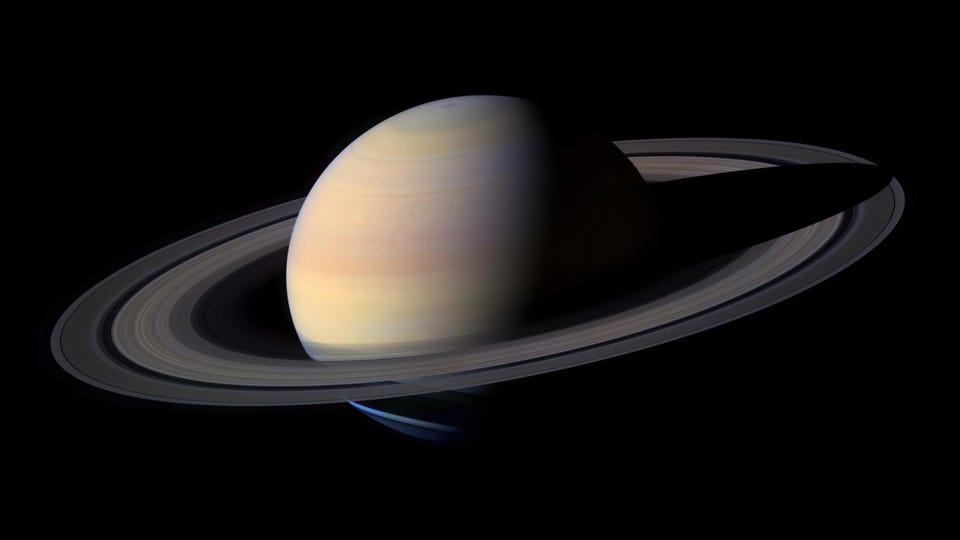Science Saturn Shines From Dusk Through Dawn As Crescent Moon Meets Jupiter And Mars: What To See In The Night Sky This Week Jamie Carter Senior Contributor Opinions expressed by Forbes Contributors are their own. I inspire people to go stargazing, watch the Moon, enjoy the night sky New! Follow this author to stay notified about their latest stories. Got it! Aug 14, 2022, 08:00pm EDT | Share to Facebook Share to Twitter Share to Linkedin Saturn and its spectacular rings.
Elements of this image were furnished by NASA. getty Each Monday I pick out the northern hemisphere’s celestial highlights (mid-northern latitudes) for the week ahead, but be sure to check my main feed for more in-depth articles on stargazing, astronomy, eclipses and more. What To Watch For In The Night Sky This Week: August 15-21, 2022 This week we continue to see the planets shuffle their way into our early evening night sky, with a Jupiter-Moon conjunction starting off a week that also sees a very bright Saturn become visible from dusk through dawn.
As the Moon continues to wane—and thus rise later at night—it will pass close to both Uranus and Mars while also moving closely past perhaps the most beautiful night sky sight of all, the Pleiades open star cluster. Here’s why, when and where you need to get looking up this week: Monday, August 15, 2022: Moon and Jupiter Stellarium Monday, August 15, 2022: Moon and Jupiter Look to the eastern horizon late this evening and you will see a 79%-illuminated waning gibbous moon just under 2º from the bright giant planet Jupiter. They should make a lovely pairing, with a pair of binoculars placed on Jupiter also revealing its four “Galilean” moons Callisto, Ganymede, Europa and Io.
MORE FOR YOU New Research Finds A Connection Between Domestic Violence And These Two Personality Disorders This Scientist Helps Andean Forests And Ecuador’s Women In STEM Exceptional Fossil Preservation Suggests That Discovering Dinosaur DNA May Not Be Impossible Thursday, August 18, 2022: Moon and Uranus Stellarium Thursday, August 18, 2022: Venus and the Beehive Cluster, Moon and Uranus Venus is still blazing away in the morning sky, today shining extremely close to one of the best naked eye open clusters in the night sky. In the boundaries of the constellation of Cancer, “The Crab,” the Beehive Cluster has around 30 easily visible stars through binoculars. Also in the morning sky you’ll be able to see an 58% waning gibbous Moon pass less than 1° from seventh planet Uranus, though you will need binoculars to see the latter.
Mars and the Pleiades will be close. Friday, August 19, 2022: Last Quarter Moon and Mars Stellarium Friday, August 19, 2022: Last Quarter Moon between Mars and the Pleiades Today is the Last Quarter Moon phase, which is when our natural satellite rises after midnight, clearing the way for 10 nights of dark, mostly moonless skies that will be ideal for both stargazing and astrophotography. As a bonus, the nights are now getting longer, and the Milky Way and its bright galactic centre are visible just after dark in the southern sky.
However, the reason to stay up late and watch the moonrise is that it will be just 2. 5° from Mars and also very close to the Pleiades open cluster of stars. What a sight! Painting of Voyager 2 spacecraft as it looks back upon Neptune and its moon Triton.
(Photo by © . . .
[+] CORBIS/Corbis via Getty Images) Corbis via Getty Images Saturday, August 20, 2022: Voyager 2 anniversary It’s 45 years ago today that NASA launched its Voyager 2 probe. Taking advantage of a rare alignment of the planets the probe visit Jupiter in 1979, Saturn in 1981, Uranus in 1986 and Neptune in 1989. Having left the solar system it’s now in interstellar space.
It will likely “go dark” in 2025. This image of Saturn was taken on 22 January 2006 using a webcam attached to a 14-inch . .
. [+] Shmidt-Cassegrain telescope. Photograph by Jamie Cooper.
(Photo by SSPL/Getty Images) SSPL via Getty Images Object of the week: Saturn Just a day past its annual opposition as this week begins, it’s a fabulous time to take a look at the six planet from the Sun through a small telescope. Although you can see Saturn with your naked eyes, and also using binoculars, only through a telescope can you see it’s fabulous ring pattern. Opposition is when Saturn is at its biggest, brightest and best, rising in the east at dusk and sitting in the west at dawn.
Wishing you clear skies and wide eyes. Follow me on Twitter or LinkedIn . Check out my website or some of my other work here .
Jamie Carter Editorial Standards Print Reprints & Permissions.
From: forbes
URL: https://www.forbes.com/sites/jamiecartereurope/2022/08/14/saturn-shines-from-dusk-through-dawn-as-crescent-moon-meets-jupiter-and-mars-what-to-see-in-the-night-sky-this-week/
